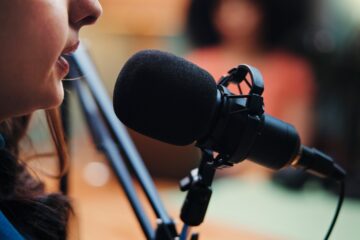‘More local, more inclusive, more interactive’
Citing public broadcasting’s “mixed history” in providing local news and information, a blue-ribbon panel has called on the field to “move quickly toward a broader vision of public service media.”
In its final report released Oct. 2 [2009], the Knight Commission on the Information Needs of Communities in a Democracy envisions a public media realm that would be “more local, more inclusive and more interactive.”
“This means pursuing greater integration of new technologies and communication practices with traditional forms of broad-casting,” the report said. “It means using digital platforms to engage local institutions effectively in the public sphere.”
“To advance this, government as well as private sector donors should condition their support of public media on its reform. They should support the creating, curating and archiving of public media content on the community level.”
Public broadcasters were ready with news to show they’re not napping. Ernest Wilson, new CPB Board chair and a formal recipient of the report, announced that CPB and the Knight Foundation will put $3 million into NPR’s Argo Project, planned to develop specialized local online reporting efforts at a dozen pilot stations (separate story). A week earlier, KQED, the University of California and philanthropist F. Warren Hellman announced a separate $5 million local reporting initiative in the Bay Area.
“If we succeed in bringing the media changes called for on this report . . . we can claim a great success,” Wilson said. “If we fail to seize these opportunities, then it will be our fault. We will have let democracy become weaker if we do not embrace, discuss and implement this report.”
Wilson, FCC Chair Julius Genachowski and other federal officials were present to receive the report at the Newseum in Washington, D.C.
The commission, funded by the John S. and James L. Knight Foundation and convened by the Aspen Institute, says Americans not only lack the information they need to participate effectively in political and civic life, but also what they need to improve their health, education and finances.
The report and a webcast of the Newseum event is posted at knightcomm.org.
Coming from a 17-member panel including old- and new-media partisans, Democrats and Republicans, the 120-page report calls for a policy and infrastructure initiative that it compares with the Interstate highway system, but it doesn’t propose spending and goals as enormous or as easy to comprehend.
Most prominently, the commission endorses faster and universally available broadband service. The FCC’s minimum speed for broadband should be 10 times faster, providing video quality equal to routine cable TV reception, the report said. Broadband is not available in one-third of rural U.S. communities. Only 25 percent of households with incomes under $20,000 a year have broadband.
The disadvantages of the broadband gap, when combined with an adult literacy gap, creates a “participation gap,” the report says, citing media scholar Henry Jenkins. Families without connected computers at home are severely limited in what they can achieve online even if they can use the Internet through public libraries.
To participate successfully, Internet users often need more media literacy and digital literacy — skills that schools and public libraries could should disseminate, the report says.
Internet users should enjoy four freedoms, the report recommends, including the rights to call up content of their choice, to use all lawful applications, to attach web devices that do no harm and to know about and choose among competing services.
The panel also speaks up for open government laws, electronic access to government data in standardized forms, and open-to-the-public deliberation and votes by legislative bodies.
To play their valuable “bridging” role among subgroups in a community, those groups must be represented in the staffing and the output of mainstream media, the panel says. Young people in particular can play an important role overcoming digital illiteracy; in what may be its most memorable image, the commission envisions a Geek Corps for Local Democracy who teach their elders about the Web.
The commission suggests that communities provide Internet access in public places and that every area have at least one well-known web portal where pertinent information can be found. But it also recognizes that face-to-face contact “remains the foundation of community building,” and endorses local, nonvirtual “summits.”
Instead of playing favorites with either old media or new media, or setting out to rescue newspapers, or helping only nonprofits, the report says the policy goals should be innovation and competition.
The most successful nonprofits “are likely to be those that succeed at developing multiple streams of revenue . . .,” the group concludes, so it recommends market incentives that help both for-profit and nonprofit efforts.
The report mentions but stops short of endorsing policies that would make it easier for nonprofits to purchase newspapers, or sales-tax exemptions for subscriptions, either print or online.
In an appendix, Peter M. Shane, an Ohio State University law professor who directed the commission’s staff, thinks up numerous policies that could flow from the report, including federal tax credits to encourage investigative journalism.
Despite the report’s hedging, Patrick Maines, president of the Media Institute, an industry think tank, said the commission deals with “little more than the most politically correct sentiments.” The report is “frivolous and ill timed” during a deep recession, Maines wrote in his blog and a guest commentary in Broadcasting & Cable. He also doesn’t like the writing. Many of the Knight panel’s paragraphs, he says, have “the density of a black hole.”
Pubcasting has “fallen short”
Second of the group’s 15 recommendations is: “Increase support for public service media aimed at community information needs.” It goes on to discuss “a modest increase” in taxpayer support “for the transformation and localization of America’s public media.”
“Public broadcasting in the United States has added a context and fullness to news and information during the past 40 years,” the panel says. “But it has fallen short of its promise. Breakthroughs in children’s programming have not been mirrored in the information field. Simply put, our public media do not fully reflect the public nor engage with it sufficiently on the community level.”
Yet the report takes care to endorse public-sector involvement in media, laying out an economic analysis: General-audience advertising, the major free-enterprise business model of journalism, has been undermined by Internet advertising and media fragmentation.
And subscriptions can’t pay the bills, either. “Just because communities need journalism,” the report explains, “does not mean that consumers in the marketplace will generate enough revenue to support that journalism.”
Providing information tends to help the broad public, the report explains, but this doesn’t bring enough profit to justify the cost for any single company. Also, the information benefits many “free rider” individuals who don’t subscribe, leading society to undervalue it. “Because so much information is a public good, communities and the country also need to make some public investments in the creation and distribution of information,” the report says.
The newspapers have collided with disruptive new technologies, said John Carroll, a commission member and former editor of the Los Angeles Times and the Baltimore Sun: New-tech burns down the house but is supposed to return later with gifts. “We’re at a time in which we we’re told … that eventually the gifts will arrive,” Carroll said during the Newseum event. “Our chances of having a happy outcome will be greatly enhanced if people in cities and towns across the America are keenly aware of what they’re getting and what they’re not getting.”





